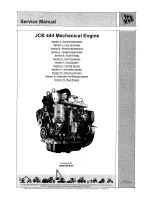
7.6
Section 7
Electrical System and Components
a. If the problem is gone, the electrical system
on the unit is suspect. Check the key switch,
wires, connections, safety interlocks, etc.
b. If the problem persists, the condition is
associated with the ignition or electrical
system of the engine. Leave the kill lead
isolated until all testing is completed.
2. Test for spark on both cylinders with Kohler
ignition tester (see Section 2). Disconnect one
spark plug lead and connect it to the post
terminal of the tester. Connect the clip to a good
ground, not to the spark plug.
Crank the engine and observe the tester spark
gap. Repeat the procedure on the other cylinder.
Remember to reconnect the
fi
rst spark plug lead.
a. If one side is not
fi
ring, check all wiring,
connections, and terminations on that side. If
wiring is okay, replace ignition module and
retest for spark.
b. If the tester shows spark, but the engine
misses or won’t run on that cylinder, try a
new spark plug.
c. If neither side is
fi
ring, recheck position of
ignition switch and check for shorted kill
lead.
Operation of DSAI Ignition Systems
DSAI Ignition System Explanation
A digital spark advance ignition system (DSAI) is
used on some models. The DSAI ignition system is an
advanced, 12-volt version of the
fi
xed timing ignition
system used on other models. Two inductive-style
ignition modules control the ignition timing based on
engine RPM. A typical DSAI application (Figure 7-6)
consists of the following components:
• A magnet assembly, which is permanently a
ffi
xed
to the
fl
ywheel.
• Two inductive, 12-volt ignition modules, which
mount on the engine crankcase (Figure 7-6).
• A 12-volt ba
tt
ery, which supplies current to the
ignition modules.
• A kill switch (or key switch) which grounds the
spark advance module to stop the engine.
• Two spark plugs.
Operation
The system provides more consistent energy to the
spark plugs at all engine speeds by using the 12-volt
ba
tt
ery as its source of power. Engine speed and top
dead center (TDC) location reference information
is provided by the
fl
ywheel magnet group as it
passes the ignition module. System triggering and
engine timing is performed by a digitally-controlled
microprocessor. This digital control provides
repeatable and consistent engine cylinder spark
timing. Each DSAI module performs its function
independently for each engine cylinder.
Summary of Contents for Comand Pro CH1000
Page 1: ...SERVICE MANUAL HORIZONTAL CRANKSHAFT CH940 CH1000...
Page 2: ......
Page 4: ......
Page 30: ...4 4 Section 4 Air Cleaner and Air Intake System...
Page 52: ...6 6 Section 6 Lubrication System...
Page 96: ...8 16 Section 8 Disassembly...
Page 110: ...Section 9 Inspection and Reconditioning 9 14...
Page 140: ...10 30 Section 10 Reassembly...
Page 141: ......
















































